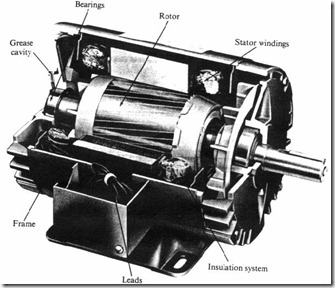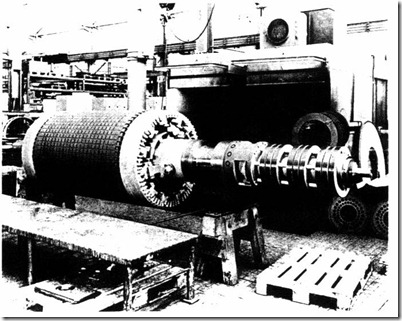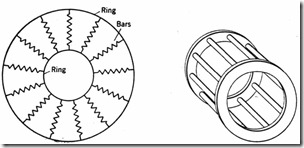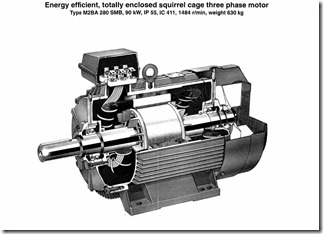The induction machine is basically an a.c. polyphase machine connected to an a.c. power grid, either in the stator or in the rotor. The a.c. power source is, in general, three phase but it may also be single phase. In both cases the winding arrangement on the part of the machine–the primary–connected to the grid (the stator in general) should produce a traveling field in the machine airgap. This traveling field will induce voltages in conductors on the part of the machine not connected to the grid (the rotor, or the mover in general), – the secondary. If the windings on the secondary (rotor) are closed, a.c. currents occur in the rotor.
The interaction between the primary field and secondary currents produces torque from zero rotor speed onward. The rotor speed at which the rotor currents are zero is called the ideal no-load (or synchronous) speed. The rotor winding may be multiphase (wound rotors) or made of bars shortcircuited by end rings (cage rotors).
All primary and secondary windings are placed in uniform slots stamped into thin silicon steel sheets called laminations.
The induction machine has a rather uniform airgap of 0.2 to 3 mm. The largest values correspond to large power, 1 MW or more. The secondary windings may be short-circuited or connected to an external impedance or to a power source of variable voltage and frequency. In the latter case however the IM works as a synchronous machine as it is doubly fed and both stator and rotor-slip frequencies are imposed.
Though historically double stator and double rotor machines have also been proposed to produce variable speed more conveniently, they did not make it to the markets. Today’s power electronics seem to move such solutions even further into oblivion.
In this chapter we discuss construction aspects and operation principles of induction machines. A classification is implicit.
The main parts of any IM are
• The stator slotted magnetic core
• The stator electric winding
• The rotor slotted magnetic core
• The rotor electric winding
• The rotor shaft
• The stator frame with bearings
• The cooling system
• The terminal box
The induction machines may be classified many ways. Here are some of them:
• With rotary or linear motion
• Three phase supply or single-phase supply
• With wound or cage rotor
In very rare cases the internal primary is the mover and the external secondary is at a standstill. In most rotary IMs, the primary is the stator and the secondary is the rotor. Not so for linear induction machines. Practically all IMs have a cylindrical rotor and thus a radial airgap between stator and rotor, though, in principle, axial airgap IMs with disk-shaped rotor may be built to reduce volume and weight in special applications.
First we discuss construction aspects of the above mentioned types of IMs and than essentials of operation principles and modes.
2.1. CONSTRUCTION ASPECTS OF ROTARY IMs
Let us start with the laminated cores.
2.1.1. The magnetic cores
The stator and rotor magnetic cores are made of thin silicon steel laminations with unoriented grain-to reduce hysteresis and eddy current losses. The stator and rotor laminations are packed into a single stack (Figure 2.1) or in a multiple stack (Figure 2.2). The latter has radial channels (5-15 mm wide) between elementary stacks (50 to 150 mm long) for radial ventilation. Single stacks are adequate for axial ventilation.
Single-stack IMs have been traditionally used below 100 kW but recently have been introduced up to 2 MW as axial ventilation has been improved drastically. The multistack concept is necessary for large power (torque) with long stacks.
The multiple stacks lead to additional winding losses, up to 10%, in the stator and in the rotor as the coils (bars) lead through the radial channels without producing torque. Also, the electromagnetic field energy produced by the coils (bar) currents in the channels translate into additional leakage inductances which tend to reduce the breakdown torque and the power factor. They also reduce the starting current and torque. Typical multistack IMs are shown in Figure 2.2.
For IMs of fundamental frequency up to 300 Hz, 0.5 mm thick silicon steel laminations lead to reasonable core losses 2 to 4 W/Kg at 1T and 50 Hz.
For higher fundamental frequency, thinner laminations are required. Alternatively, anisotropic magnetic powder materials may be used to cut down the core losses at high fundamental frequencies, above 500 Hz, however at lower power factor (see Chapter 3 on magnetic materials).
2.1.2. Slot geometry
The airgap, or the air space between stator and rotor, has to be traveled by the magnetic field produced by the stator. This in turn will induce voltages and
produce currents in the rotor windings. Magnetizing air requires large magnetomotive forces (mmfs) or amperturns. The smaller the air (nonmagnetic) gap, the smaller the magnetization mmf. The lower limit of airgap g is determined by mechanical constraints and by the ratio of the stator and slot openings bos, bor to airgap g in order to keep additional losses of surface core and tooth flux pulsation within limits. The tooth is the lamination radial sector between two neighbouring slots.
Putting the windings (coils) in slots has the main merit of reducing the magnetization current. Second, the winding manufacture and placement in slots becomes easier. Third, the winding in slots are better off in terms of mechanical rigidity and heat transmission (to the cores). Finally the total mmf per unit length of periphery (the coil height) could be increased and thus large power IMs could be built efficiently. What is lost is the possibility to build windings (coils) that can produce purely sinusoidal distributed amperturns (mmfs) along the periphery of the machine airgap. But this is a small price to pay for the incumbent benefits.
The slot geometry depends mainly on IM power (torque) level and thus on the type of magnetic wire–with round or rectangular cross section–from which the coils of windings are made. With round wire (random wound) coils for small power IMs (below 100 kW in general), the coils may be introduced in slots wire by wire and thus the slot openings may be small (Figure 2.3a). For preformed coils (in large IMs), made, in general, of rectangular cross-section wire, open or semiopen slots are used (Figure 2.3b, c).
In general, the slots may be rectangular, straight trapezoidal, or rounded trapezoidal. Open and semiopen slots tend to be rectangular (Figure 2.3b, c) in shape and the semiclosed are trapezoidal or rounded trapezoidal (Figure 2.3a). In an IM, only slots on one side are open, while on the other side, they are semiclosed or semiopen.
The reason is that a large slot opening, bos, per gap, g, ratio (bos/g > 6) leads to lower average flux density, for given stator mmf and to large flux pulsation in the rotor tooth, which will produce large additional core losses. In the airgap flux density harmonics lead to parasitic torques, noise, and vibration as presented in subsequent, dedicated, chapters. For semiopen and semiclosed slots, bos/g ≅ (4-6) in general. For the same reasons, the rotor slot opening per airgap bor/g ≅ 3-4 wherever possible. Too small a slot opening per gap ratio leads to a higher magnetic field in the slot neck (Figure 2.3) and thus to a higher
slot leakage inductance, which causes lower starting torque and current and lower breakdown torque.
Slots as in Figure 2.3 are used both for stator and wound rotors. Rotor slot geometry for cage-rotors is much more diversified depending upon
• Starting and rated load constraints (specifications)
• Constant voltage/frequency (V/f) or variable voltage/frequency supply operation
• Torque range.
Less than rated starting torque, high efficiency IMs for low power at constant V/f or for variable V/f may use round semiclosed slots (Figure 2.4a).
Rounded trapezoidal slots with rectangular teeth are typical for medium starting torque (around rated value) in small power IMs (Figure 2.4b).
Closed rotor slots may be used to reduce noise and torque pulsations for low power circulating fluid pumps for homes at the expense of large rotor leakage inductance; that is, lower breakdown torque. In essence the iron bridge (0.5 to 1 mm thick), above the closed rotor slot, already saturates at 10 to 15% of rated current at a relative permeability of 50 or less that drops further to 15 to 20 for starting conditions (zero speed, full voltage).
a.) high slip, high starting torque b.) moderate starting torque c.) very high starting torque For high starting torque, high rated slip (lower rated speed with respect to ideal no-load speed), rectangular deep bar rotor slots are used (Figure 2.5a). Inverse trapezoidal or double cage slots are used for low starting current and moderate and large starting torque (Figure 2.5b, c). In all these cases, the rotor slot leakage inductance increases and thus the breakdown torque is reduced to as low as 150 to 200% rated torque.
At the start, the frequency of rotor currents is equal to stator (power grid) frequency f1, while at full load fsr = Snf1; Sn, the rated slip, is about 0.08 and less than 0.01 in large IMs:
S = f1 −np1 ; n -speed in rps (2.1) f1
p1 is the number of spatial periods of airgap traveling field wave per revolution produced by the stator windings:
Bg0 (x,t)= Bgm0 cos(p1 1θ − ω1t) (2.2) θ1-mechanical position angle; ω1 = 2πf1.
Remember that, for variable voltage and frequency supply (variable speed), the starting torque and current constraints are eliminated as the rotor slip frequency Sf1 is always kept below that corresponding to breakdown torque. Very important in variable speed drives is efficiency, power factor, breakdown torque, and motor initial or total costs (with capitalized loss costs included).
2.1.3. IM windings
The IM is provided with windings both on the stator and on the rotor. Stator and rotor windings are treated in detail in Chapter 4.
Here we refer only to a primitive stator winding with 6 slots for two poles (Figure 2.6).
Figure 2.6 Primitive IM with 6 stator slots and cage rotor
Each phase is made of a single coil whose pitch spans half of rotor periphery. The three phases (coils) are space shifted by 120°. For our case there are 120° mechanical degrees between phase axes as p1 = 1 pole pair. For p1 = 2, 3, 4, 5, 6, there will be 120°/p1 mechanical degrees between phase axes.
The airgap field produced by each phase has its maximum in the middle of the phase coil (Figure 2.6) and, with the slot opening eliminated, it has a rectangular spatial distribution whose amplitude varies sinusoidally in time with frequency f1 (Figure 2.7).
It is evident from Figure 2.7 that when the time angle θt electrically varies by π/6, so does the fundamental maximum of airgap flux density with space harmonics neglected, a travelling wavefield in the airgap is produced. Its direction of motion is from phase a to phase b axis, if the current in phase a leads (in time) the current in phase b, and phase b leads phase c. The angular speed of this field is simply ω1, in electrical terms, or ω1/p1 in mechanical terms (see also Equation (2.2)).
This is how the ideal no load speed for 50(60) Hz is 3000/3600 rpm for p1 = 1, 1500/1800 rpm for p1 = 2 and so on.
As the rated slip Sn is small (less than 10% for most IMs), the rated speed is only slightly lower than a submultiple of f1 in rps. The crude configuration in Figure 2.7 may be improved by increasing the number of slots, and by using two layers of coils in each slot. This way the harmonics content of airgap flux density diminishes, approaching a better pure traveling field, despite the inherently discontinuous placement of conductors in slots.
A wound stator is shown in Figure 2.8. The three phases may be star or delta connected. Sometimes, during starting, the connection is changed from star to delta (for delta-designed IMs) to reduce starting currents in weak local power grids.
Figure 2.8 IM wound three-phase stator winding with cage rotor
Wound rotors are built in a similar way (Figure 2.9). The slip rings are visible to the right. The stator-placed brush system is not. Single-phase-supply IMs have, on the other hand, in general, two windings on the stator.
The main winding (m) and the auxiliary (or starting) one (a) are used to produce a traveling field in the airgap. Similar to the case of three phases, the two windings are spatially phase shifted by 90° (electrical) in general. To phase shift the current in the auxiliary winding, a capacitor is used.
Figure 2.9 Three-phase wound rotor
In reversible motion applications, the two windings are identical. The capacitor is switched from one phase to the other to change the direction of traveling field.
When auxiliary winding works continuously, each of the two windings uses half the number of slots. Only the number of turns and the wire cross-section differ.
The presence of auxiliary winding with capacitance increases the torque, efficiency, and power factor. In capacitor-start low-power (below 250 W) IMs, the main winding occupies 2/3 of the stator slots and the auxiliary (starting) winding only 1/3. The capacitor winding is turned off in such motors by a centrifugal or time relay at a certain speed (time) during starting. In all cases, a cage winding is used in the rotor (Figure 2.10). For very low power levels (below 100 W in general), the capacitor may be replaced by a resistance to cut cost at the expense of a lower efficiency and power factor.
Finally, it is possible to produce a traveling field with a single phase concentrated coil winding with shaded poles (Figure 2.11). The short-circuiting ring is retarding the magnetic flux of the stator in the shaded pole area with respect to the unshaded pole area.
The airgap field has a traveling component and the motor starts rotating from the unshaded to the shaded pole zone. The rotor has a cage winding. The low cost and superior ruggedness of shaded pole single phase IM is paid for by
a lower efficiency and power factor. This motor is more of historical importance and is seldom used, usually below 100 W, where cost is the prime concern.
2.1.4. Cage rotor windings
As mentioned above, the rotor of IMs is provided with single or double cage windings (Figure 2.12), in addition to typical three phase windings on wound rotors.
Figure 2.12 Cage rotor windings
a.) single cage b.) double cage
The cage bars and end rings are made of diecast aluminum for low and medium power and from brass or copper for high powers. For medium and high powers, the bars are silver-rings−welded to end to provide low resistance contact.
For double cages brass may be used (higher resistivity) for the upper cage and copper for the lower cage. In this case, each cage has its own end ring, mainly due to thermal expansion constraints.
For high efficiency IMs copper tends to be preferred due to higher conductivity, larger allowable current density, and working temperatures. The diecasting of aluminum at rather low temperatures results in low rotor mass production costs for low power IMs.
Figure 2.13 Cutaway view of a modern induction motor
The debate over aluminum or copper is not yet decided and both materials are likely to be used depending on the application and power (torque) level.
Although some construction parts such as frames, cooling system, shafts, bearings, and terminal boxes have not been described here, we will not dwell on them at this time as they will be discussed again in subsequent chapters. Instead, Figure 2.13 presents a rather complete cutaway view of a fairly modern induction motor. It has a single stack magnetic core, thus axial ventilation is used by a fan on the shaft located beyond the bearings. The heat evacuation area is increased by the finned stator frame. This technology has proven practical up to 2 MW in low voltage IMs.
The IM in Figure 2.13 has a single-cage rotor winding. The stator winding is built in two layers out of round magnetic wire. The coils are random wound. The stator and rotor slots are of the semiclosed type. Configuration in Figure 2.13 is dubbed as totally enclosed fan cooled (TEFC), as the ventilator is placed outside bearings on the shaft.
It is a low voltage IM (below 690 V RMS−line voltage).











